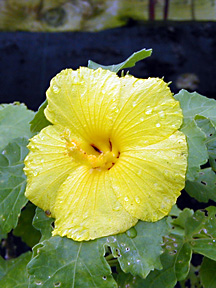|
In the Garden
|
State flower endangered
Hibiscus brackenridgei
(Hawaii's official state flower)
Description: This shrub grows up to 10 feet, with maple-like leaves and bright yellow flowers. This plant varies in appearance between islands but generally falls into two subspecies: H.brackenridgei subspecies brackenridgei of Maui, Molokai, Lanai and Hawaii and H. brackenridgei subspecies mokuleianus of Oahu and Kauai.
 The most visible difference between the two subspecies is in the leaves and stems. Subspecies mokuleianus has leaves with serrated margins and pink veins, with tiny spines on the branches. Meanwhile, subspecies brackenridgei has leaves with more rounded margins and yellow veins, without the spines.
The most visible difference between the two subspecies is in the leaves and stems. Subspecies mokuleianus has leaves with serrated margins and pink veins, with tiny spines on the branches. Meanwhile, subspecies brackenridgei has leaves with more rounded margins and yellow veins, without the spines.
Recently, a variety of H. brackenridgei from Makua Valley on Oahu was discovered with characteristics of both subspecies. Its leaves resemble those of the subspecies brackenridgei, but it has the pink veins of subspecies mokuleianus, and although it is from Oahu, it lacks the branch thorns of subspecies mokuleianus.
Distribution: The endangered species is found in the dry to mesic forests of all the main islands except Niihau (it was once reportedly collected from Kaho'olawe as well).
Landscape uses and care: Ma'ohauhele does well in full sun to partial shade and needs very little water to thrive, although daily watering is OK. It is a fast grower and will flower about twice a year. Each flowering period lasts up to two months, with blooms appearing daily on a flowering stalk that towers over the rest of the plant.
Unlike most hibiscuses, this plant doesn't perform well as a hedge. It looks best as a specimen plant. Rose beetles may attack its leaves at night, giving them the appearance of Swiss cheese. To prevent this, plant it near a night-time light source. Leave the lights on from dusk until at least 8 or 9 p.m. to keep most of the nasty munchers away. Whiteflies may sometimes be found under the leaves, but any store-bought pesticide should fix that problem.
Note: In 1988, Hawaii changed its state flower from the native red hibiscus (Hibiscus kokio) to this one. This is the only species of yellow hibiscus that can be called our state flower.
![]()
[News] [Business] [Features] [Sports] [Editorial] [Do It Electric!]
[Classified Ads] [Search] [Subscribe] [Info] [Letter to Editor]
[Feedback]
